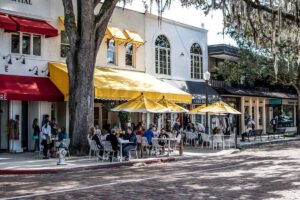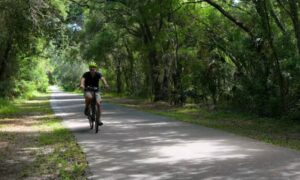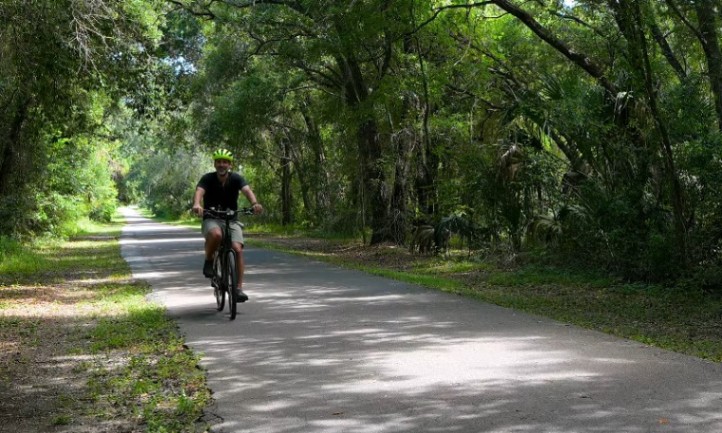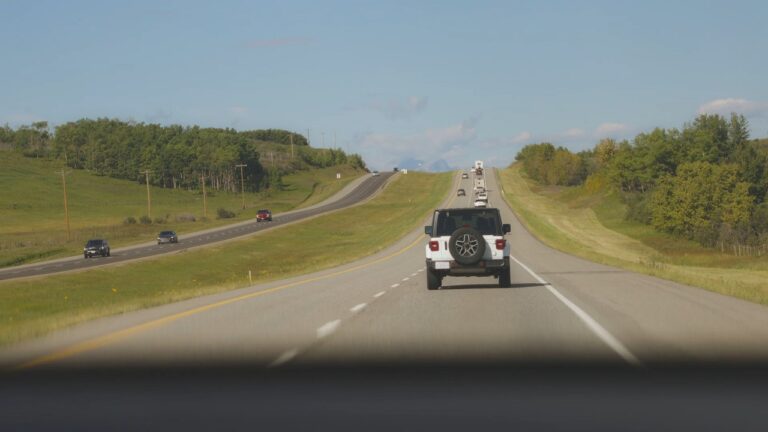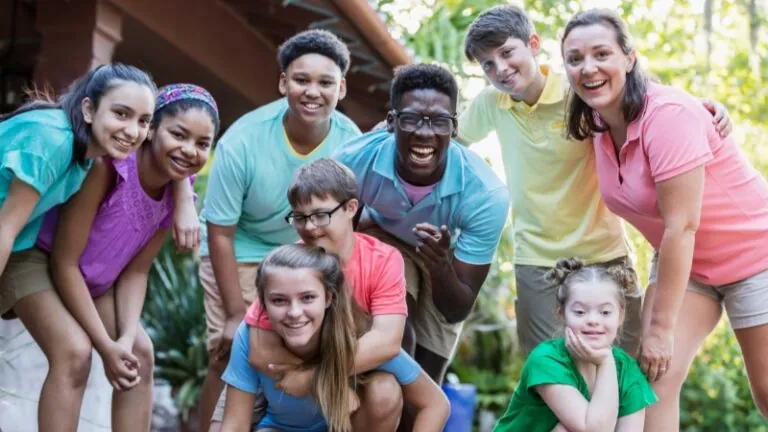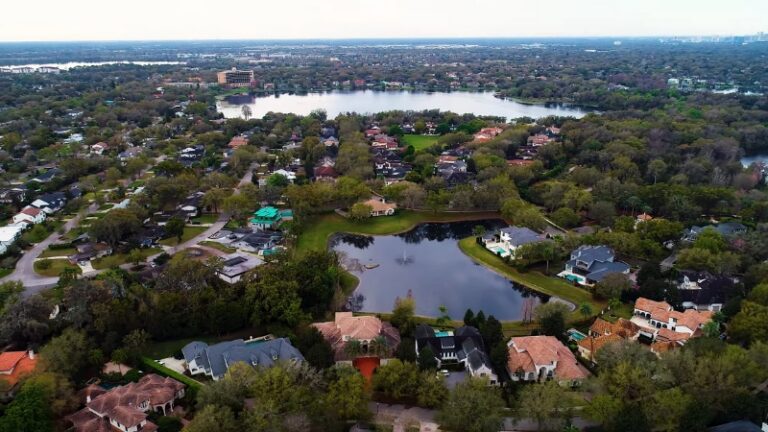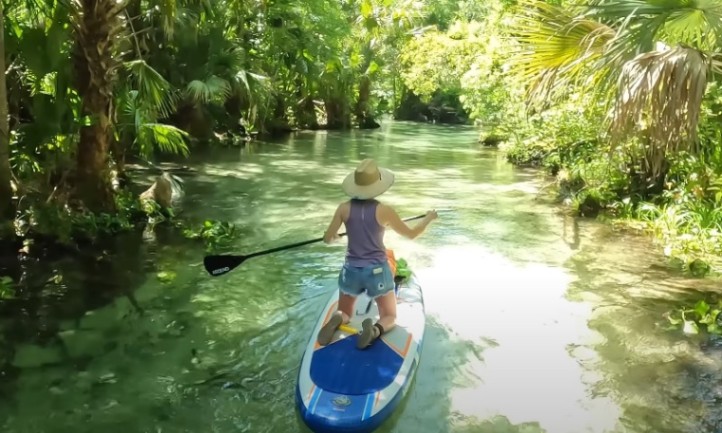
Central Florida spoils paddlers. Within an easy drive of Orlando, you can find crystal springs that run clear for miles, shaded blackwater creeks, grassy rivers that twist through the pines, and wide coastal lagoons where dolphins surface just a few feet away.
The variety is unmatched, and the access is easy, whether you travel with your own gear or rent locally.
Here are some of the most attractive locations for paddleboarding and kayaking you can visit.
Table of Contents
ToggleQuick Picks at a Glance
| Waterbody | Nearest Town | Best For | Typical Distance | Skill Level | Launch Notes |
| Wekiwa Springs & Rock Springs Run | Apopka | Clear spring run, wildlife, mild current | 4 to 8 miles common | Beginner to intermediate | Launch from Wekiwa Springs or King’s Landing. Rentals available. |
| Silver Springs & Silver River | Ocala | Big spring flow, fish and turtles under you, easy downstream shuttle | 5 miles one way to Ray Wayside | Beginner | Park concession offers SUPs, kayaks, and shuttle. |
| Shingle Creek | Kissimmee | Cypress shade, birds, easy urban nature fix | 1 to 2 miles out-and-back | Beginner | Launch at Steffee or Babb Landing. Rentals at Steffee. |
| Winter Park Chain of Lakes | Winter Park | Canal cruising, gardens, urban scenery | 3 to 5 mile loops | Beginner | Launch at Dinky Dock Park. Low bridges in canals. |
| Econlockhatchee River & Little Big Econ | Oviedo, Geneva | Rustic blackwater, sand bars, gentle current | 8 to 20 miles | Intermediate | State forest launches, primitive camping zones. |
| Lake Louisa State Park | Clermont | Calm lakes, easy SUP practice, sunsets | Flexible out-and-back | Beginner | Hand-launch lakes, no gas motors. Rentals on site. |
| Blue Spring area, St. Johns River | Orange City | Manatees in winter, river paddling year-round | Flexible routes | Beginner | Spring run closed during manatee season; river open. |
| Mosquito Lagoon, Canaveral NS & Merritt Island NWR | Titusville, New Smyrna Beach | Saltwater flats, mangroves, summer bioluminescence | Choose your loop | Beginner to intermediate | Multiple ramps and hand launches. Night rules vary. |
Wekiwa Springs and Rock Springs Run
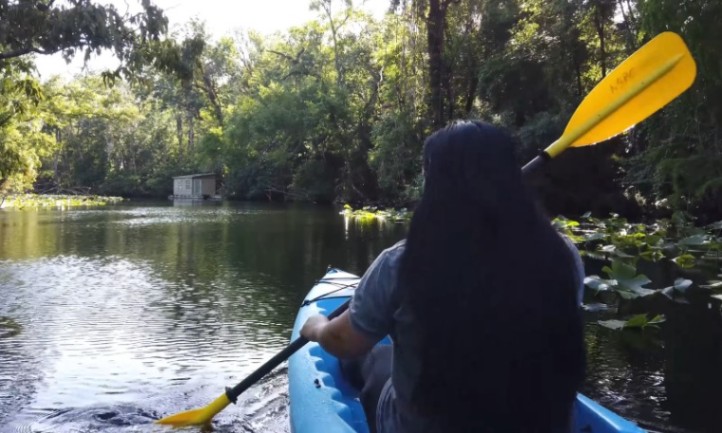
Two clear spring-fed systems meet north of Orlando to form one of Florida’s most beloved paddling trails. Wekiwa Springs State Park offers a simple launch with rentals, restrooms, and a clear run downstream lined with palms and cypress.
The current is light, perfect for a steady paddle or relaxed float. Wildlife shows up constantly, turtles sunning on logs, otters rolling in eddies, and herons along the banks.
From Wekiwa Springs you can drift downstream or plan a longer point-to-point trip toward the St. Johns River. If you want the classic Emerald Cut photos, launch at King’s Landing on Rock Springs Run .
The first mile winds through a shaded corridor so green it looks unreal. From there, you can continue downstream to meet the Wekiva River. Outfitters offer self-guided rentals and shuttles back, so you do not need to paddle upstream.
Distance tip: The entire designated Wekiva–Rock Springs Run trail covers about 27 miles, but most paddlers keep outings under 8 miles. Overnight camping on sandbars and islands is allowed with a state permit.
When to Go
Spring and fall bring moderate flows, clear water, and fewer crowds. Weekends fill early, so book rentals in advance. Early mornings also increase your chances of spotting manatees where the Wekiva meets the St. Johns.
Silver Springs and the Silver River
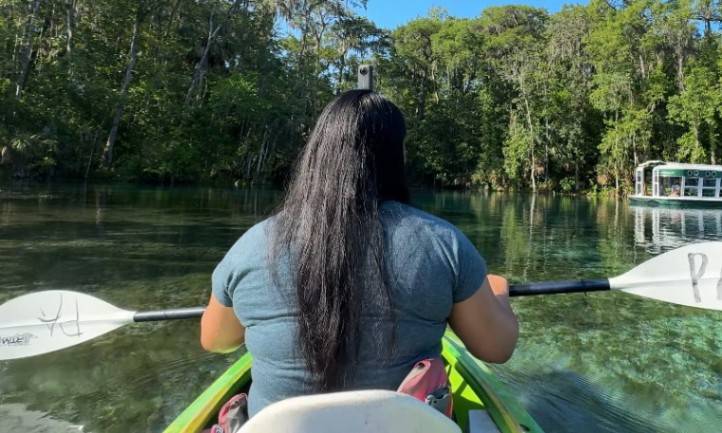
Silver Springs is legendary for a reason. The water is so clear you can see fish moving against the current beneath your board. From the headspring in Ocala , the flow carries you gently five miles downstream to Ray Wayside Park , where a concession-run shuttle returns you to your car.
The park rents kayaks, canoes, and paddleboards, all ready to launch steps from the glass-bottom boats that also tour the headspring area. Those boats stay near the source, while paddlers glide past submerged logs, ancient fish, and gentle bends under hanging oaks.
Pro Tip
If you bring your own board or kayak, stage a car at Ray Wayside before launching to make your trip effortless. Afternoon winds can pick up through the open bends, so aim for morning departures.
Shingle Creek
Few expect real wilderness inside Kissimmee, but Shingle Creek proves it’s there. Cypress knees line the water, birds call overhead, and the flow is mild enough for anyone to handle.
Orange County manages the Shingle Creek Regional Park paddling trail , which offers access at Steffee Landing and Babb Landing . Steffee Landing has rentals, parking, and picnic areas, making it a stress-free option for families or first-timers.
The typical out-and-back route covers one to two miles through shaded turns. You can combine your paddle with a walk on the park’s trails or a picnic under the cypress.
Why Locals Like It
It’s quiet but close, giving you nature without the long drive. Morning hours are ideal for spotting herons and wood ducks when the air is still.
Winter Park Chain of Lakes
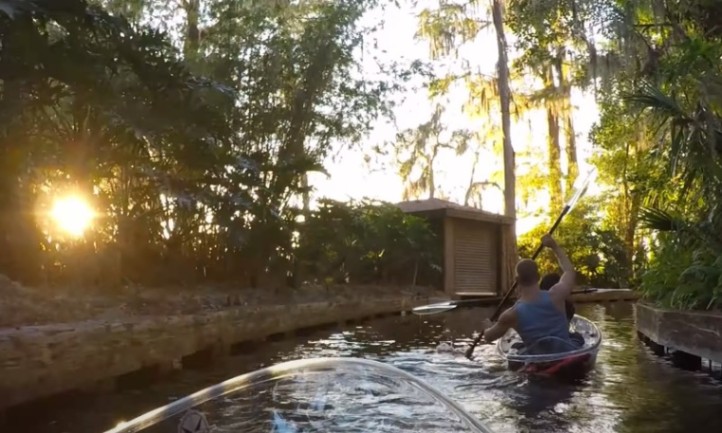
For calm canals and historic scenery, the Winter Park Chain is a gem right inside the city. Launch from Dinky Dock Park on Lake Virginia and connect through narrow canals lined with lush gardens, private boathouses, and overhanging camphor trees.
The typical loop runs from Virginia through Genius Canal to Lake Mizell, then through Fern Canal to Lake Osceola. Add Lake Maitland for a longer trip. It’s about 4 to 5 miles total at an easy pace.
Winter Park manages boating rules on the chain, including bridge height and motor restrictions. Non-motorized craft launch for free at Dinky Dock. Watch for the wide scenic tour boats that run scheduled routes; give them the right of way through canals.
Small City Tips
Parking fills by midmorning, especially on weekends. Bring a soft bumper or paddle cover because canal walls are narrow and concrete in some spots.
Econlockhatchee River and Little Big Econ
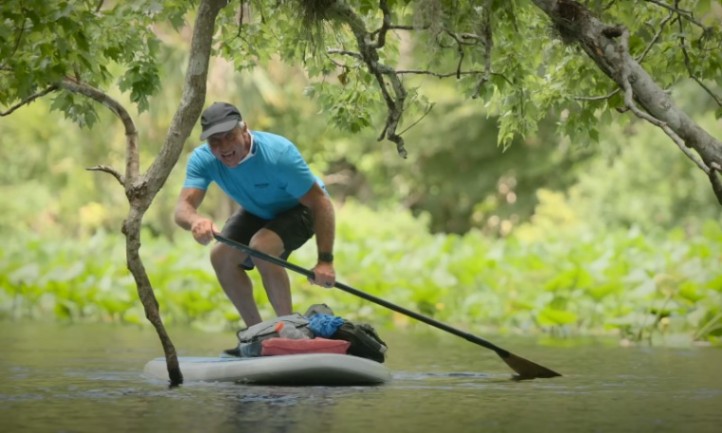
If you prefer rustic, the Econlockhatchee River and its continuation, the Little Big Econ , deliver quiet miles away from development. The tea-colored water reflects tall pines and oaks, and the sandy bottom gives way to sandbars perfect for breaks.
There are three main put-ins noted on the Florida Department of Agriculture and Consumer Services paddling map. Depending on where you start, often the Little Big Econ State Forest Canoe Launch or Snow Hill Road Bridge , you can choose 8-, 12-, or 20-mile sections.
Primitive camping is allowed in designated forest zones, and it’s common to see other paddlers staging overnight trips.
After heavy rain, the current moves faster, and you may need to maneuver around downed trees. In dry months, expect shallow stretches that require a few short drags.
Field Notes
- Cell service can drop in forested sections.
- Bring extra drinking water; few public stops exist.
- Fall and winter bring cooler, bug-free conditions and lower humidity.
Lake Louisa State Park and the Clermont Chain
Lake Louisa State Park , southwest of Orlando, sits on three major lakes connected by small channels. It’s a calm and safe area for SUP beginners or anyone refining strokes and balance.
The park concession rents kayaks and paddleboards, and no gas motors are allowed. That keeps the water glassy, even on breezy days. The sunsets here are some of the best in Central Florida, with the rolling hills of Clermont in the distance.
If the wind rises, hug the shoreline and use small coves to rest between stretches. Summer storms pass quickly, but always bring a dry bag for electronics.
Park Tip
You can combine a paddle with a short hike or bike ride. The park has 20 miles of trails, all accessible with a single day fee.
Blue Spring State Park and the St. Johns River
View this post on Instagram
A post shared by Get Up And Go Kayaking – Gilchrist Blue (@getupandgogilchristblue)
Blue Spring State Park near Orange City becomes a sanctuary for manatees each winter. From roughly mid-November through March, the park closes the spring run to swimmers and paddlers to protect the animals.
Outside of that window, the run reopens and offers a calm, teal-water paddle that feels almost surreal.
Even when the run is closed, you can still paddle the St. Johns River and its connected backwaters. The concession inside the park rents kayaks and offers guided trips.
The river remains open year-round and is one of Florida’s most scenic flatwater experiences, full of wading birds and cypress draped in moss.
Visitor Tip
Arrive early. Blue Spring reaches capacity most mornings by 10 a.m. during winter, especially on weekends. When full, gates close until midday.
Mosquito Lagoon, Canaveral National Seashore, and Merritt Island NWR
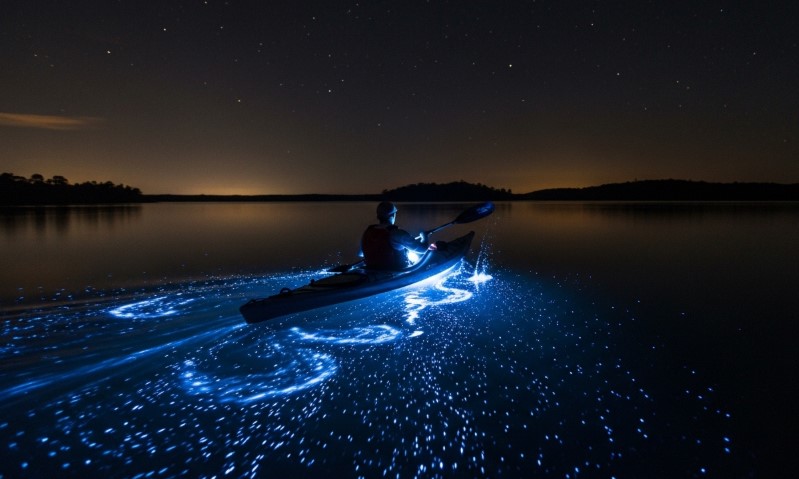
If saltwater and big sky call to you, Mosquito Lagoon is the spot. The lagoon stretches between Titusville and New Smyrna Beach within Canaveral National Seashore and Merritt Island National Wildlife Refuge . The water is shallow and dotted with mangrove islands, perfect for exploring.
You can launch from Apollo Beach , Haulover Canal , or one of the small hand-launch sites near the refuge roads. Dolphins and manatees are common, and birdlife is incredible. Conditions depend on wind and tide, so plan your route using NOAA tide charts and check weather forecasts before committing to open crossings.
Bioluminescent Season
From late June through September, the lagoon glows at night thanks to dinoflagellates, microscopic plankton that light up when disturbed.
Several outfitters run guided night tours, and the refuge posts clear rules about where night use is allowed. Bring a whistle, PFD, and white light for visibility.
Practical Advice
Summer afternoons often bring sea breezes that make the open flats choppy. Start early, or join a night tour to see the glow under calm conditions.
Trip Planning Tips That Matter in Central Florida
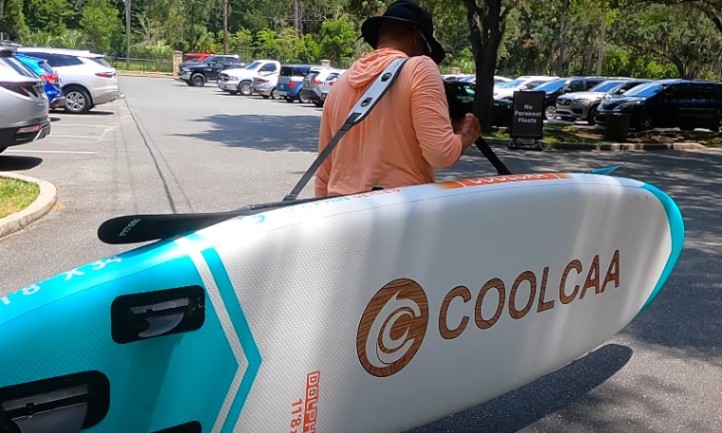
Before heading out, a little planning makes all the difference. Central Florida’s waterways can shift with weather, crowds, and seasonal closures, so knowing a few local rules and habits helps every trip go smoother.
1. Life Jackets and Safety Gear
Florida law requires every paddler to have a USCG-approved personal flotation device (PFD) . Children under six must wear one while underway. Each vessel must carry a whistle or similar sound device.
If you paddle in coastal waters after dark, bring a white light and visual distress signal. Full details appear on the Florida Fish and Wildlife Conservation Commission (FWC) website.
2. Sharing Space with Alligators
You’ll see gators on many freshwater routes. Keep a respectful distance, avoid feeding them, and never let pets near the water.
If a gator slides in from a bank, just move calmly past and continue paddling. Spring nesting season means extra caution near shoreline vegetation.
If this is too much for you, and you prefer watching, learn more about Gatorland.
3. Seasonal Closures and Park Capacity
Some parks close portions of water to protect wildlife, like Blue Spring during manatee season.
Many also reach capacity on weekends and holidays. Always check Florida State Parks’ online alerts before heading out.
4. Weather and Water Conditions
Afternoon thunderstorms are routine from May through September. Start early, monitor radar, and keep an eye on the clouds.
On open lakes or lagoons, wind creates the biggest challenge. Use tree lines and mangrove edges to stay sheltered.
5. Rentals and Shuttles
You can rent gear at most major sites:
- Wekiwa Springs State Park
- Silver Springs State Park
- Blue Spring State Park (river routes)
- Shingle Creek at Steffee Landing
- Lake Louisa State Park
- King’s Landing (Rock Springs Run, with shuttle)
Reserve in advance for weekends or holidays.
Suggested Itineraries
Whether you have a few hours or a full day to spare, Central Florida offers routes that match any schedule. Here are a few local favorites worth trying.
Half Day
Start early at King’s Landing for an out-and-back through the Emerald Cut. Float downstream a bit, then return and grab lunch in Apopka . If you still have energy, cool off at Wekiwa Springs before heading home.
Full Day
Book a kayak or SUP at Silver Springs , paddle the five-mile route to Ray Wayside Park , and enjoy the return shuttle. Expect clear views of fish and turtles the whole way.
Urban Canals and Gardens
Launch before 9 a.m. at Dinky Dock Park , loop the connected Winter Park lakes, and stop for coffee afterward. Always check city notices for parking and temporary closures.
Saltwater Glow Night
Join a bioluminescent tour on Mosquito Lagoon . Confirm the meeting spot and rules for night lighting. Bring bug spray, water, and a towel, as you’ll want to linger after sunset.
What to Pack for Central Florida Paddling
- USCG-approved PFD for everyone
- Whistle or horn attached to PFD
- Waterproof phone case and printed map or screenshot
- Hat, UPF-rated shirt, sunscreen, polarized sunglasses
- Water and snacks in a small cooler or dry bag
- Sandal-style footwear that grips wet surfaces
- Headlamp or deck light for dusk returns
- Bug spray, especially in mangroves
- Trash bag to pack out what you bring
Heat and Hydration
Central Florida’s heat sneaks up fast on the water. Hydrate before you go, not just during.
Refill bottles at parks when you can, and wear breathable long sleeves instead of relying on sunscreen alone.
Leave No Trace in Springs and Lagoons
The state’s clear waters are fragile. Avoid standing on seagrass or spring vents, and paddle lightly through eelgrass zones to prevent scarring the bottom. Keep your distance from wildlife and respect anglers and boaters at launch areas.
In Mosquito Lagoon, powerboats share some channels. Cross them decisively and only where you can see both ways.
Dispose of trash properly and rinse gear after each trip to prevent spreading invasive species between freshwater and saltwater systems.
The goal is simple: leave the water cleaner than you found it.
Final Words
Central Florida rewards anyone who shows up early, packs smart, and keeps things simple.
If you want the clarity and color of bottled water, Silver Springs and Rock Springs Run never disappoint.
For quiet shade and short drives, Shingle Creek or Lake Louisa are easy wins. And if you crave open horizons with dolphins and night glows, Mosquito Lagoon is your spot.
Pick a forecast, grab your paddle, and let the region’s springs, rivers, and lagoons handle the rest.
Related Posts:
- 5 Reasons to Attend Taste! Central Florida You Should Know
- 10 Best Bars in Downtown Orlando for 2025 - Top…
- 15 Must-Try Restaurants in Winter Park in 2025 -…
- Where Do Orlando Locals Go on Vacation? Top 12…
- Brunching in Orlando - 10 Must-Try Spots for Food…
- How Florida Weather Impacts Your Roof and Driveway…



